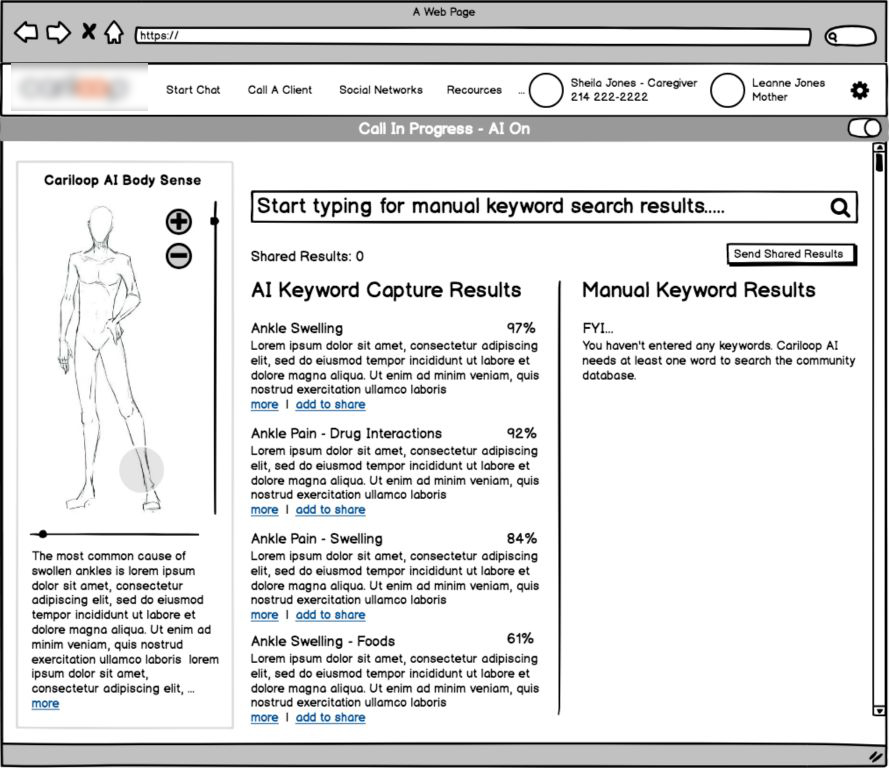The Design Thinking framework is simple. First, you empathize with your users. Next you define the problem. Once the problem is identified, you ideate for solutions. Once a solution has been found, it is time to prototype. With prototype in hand, it is time to validate your idea with real users. If the idea is a good one, it is time to invest and move forward to make a great product or experience.
EMPATHIZE
The Empathy Map for a caregiver
The first step in our process was to observe, engage, and listen with both coaches and caregivers within a start-up benefit company. Each member of Bohemian Empathy interviewed people who could be caregivers or who were previously caregivers. With this information and personas provided by the company, we created an empathy map to better understand our users, their wants, and their needs.
With this exercise, we got insight into what the caregivers and coaches say, think, their actions, and how they feel. With our research, we found that caregivers did not know where to start, thought they had no help, Googled their next steps and felt stress, confused and alone.
Coaches also felt similar things and questioned where to find reliable information for their caregivers. They thought they needed updated information, spent most of their time Googling answers, and felt a lot of stress and doubt about the help they were giving their caregivers
Define
Once we understood our coaches and caregivers better, we were given a rough journey map of the four stages of the company’s process. Once we went through these together, we studied each stage and identified what we thought might be pain points for each step of the process. After much discussion, Bohemian Empathy decided to focus on helping coaches to confidently find the information they needed for their caregivers.
With our problem defined, we were ready to begin thinking solutions.






Ideate
When we began thinking of ideas to solve the coaches’ problem, we first began with "how might we…?" statements to try and get our thinking going. We discussed broadly what needs should be addressed for the company's coaches while trying not to focus on feasibility. We simply wanted good ideas to come out and find the best solution to our problem.
In the end we focused on how might we:
Provide resources?
Communicate effectively?
Keep up with state laws?
Validate research?
Help coaches send their findings?
From there, we began to come up with big ideas and "it's kinda like" to further get our thinking and ideas going.
Once we defined our problem, we started to think of solutions. In order to stay broad with our solutions, we described them in "it's kinda like" statements. We were told to get one crazy idea off our chests and then move on to more feasible solutions/ideas. We then sorted our ideas once again to see if there were any common themes. Our favorite crazy idea was a t-rex that did not work out, but we were able to really pin down how we wanted the problem to be solved.













Next, we took our ideas and put them on a feasibility chart. We discussed what were basic ideas (no brainers), differentiators, performance payoffs, and unwise ideas. Along this spectrum we also discussed what was high impact to our users and what would be hard for the company to implement. After much discussion, we came to a consensus and was ready to really define what our goal for the problem would be.



























With our ideas defined and thought through, we created the first draft of our theme statement. After meeting in person and really tackling our idea, we came up with our final theme statement: In five minutes or less, a [start-up company’s] coach will provide caregivers with the reliable resources needed from their interactive knowledge toolbox platform. With our idea defined, it was time to prototype and bring our idea to life.










Prototype
First we discussed which method of presenting our idea would be better - a storyboard or a prototype. In the end, it was decided to do both in order to show the full impact of it to the start-up’s coaches and their caregivers. In the same meeting, we came up with ideas of what we thought our service would look like.
After much discussion, we each made our own version of what we thought the service would look like. After discussing again, we pulled the parts we liked from each to create a common prototype all of us could agree on. Using this prototype, we could successfully model the service and really feel its impact. We tested it on a few people around us to get some validation, but it would need more strenuous testing to ensure it was at the best standard that it could be.
















On our last day of class, we presented our ideas to members of the company and its CEO. They liked our idea and the potential it had to help their coaches to be successful in helping their caregivers long term.
Summary
Bohemian Empathy experienced the design thinking framework from start to finish. We developed empathy for the company’s users and coaches. Through that empathy we identified their pain points and discovered areas we felt we could improve. Through discussion and collaboration we vetted those ideas and developed a working prototype. Now that we have hands-on experience with this process, we will be able to apply it to any project we come across. We learned a lot and had a lot of fun doing it.

